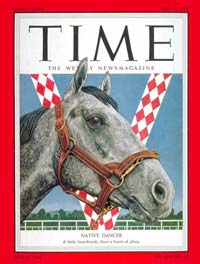"...the big gray [horse] does it without any effort. He actually seems to be holding himself back." (Bill Winfrey, trainer of Native Dancer)

Eddie Arcaro, disc jockey, has the most wins (six) at the Belmont Stakes. Photo courtesy www.belmontstakes.com

Eddie Arcaro, disc jockey, has the most wins (six) at the Belmont Stakes. Photo courtesy www.belmontstakes.com
In June of 1953, horse lovers pulled up in their convertibles at Belmont Park on Long Island in New York. They dressed in suits and fedoras, in evening gowns and designer hats. They were joined by the local media: whereas in the 1930's, radio broadcasters covered horse races, by the 1950's, television broadcasters dominated the event. The band played an old waltz called "The Sidewalks of New York". The guests dined on traditional fare.

www.belmontstakes.com
The horse fans headed to the grandstand while the media headed to the infield. Bets were placed on the heavy favourites including Jamie K., Ram O' War and Native Dancer. The latter, nicknamed "The Gray Ghost", had been named Horse of the Year in 1952. Five weeks before Belmont, it had narrowly lost the Kentucky Derby to another horse named Jamie K. Not accustomed to losing, the loss had been blamed on the gray horse's trainer: "Eric [Guerin] had taken Native Dancer everywhere on the field but the ladies' room". But two weeks after the Derby, Native Dancer was back in fine form and he clinched the title at the Preakness Stakes.

www.galleryofchampions.com
As the groom prepped Native Dancer for the race, "Black Cat", who travelled with the horse, purred in his stall. The trainer waited anxiously by the stall. The Gray Ghost's owner, Alfred Vanderbilt, waited in the grandstand.
Television cameramen trained their cameras on the gates as the six horses entered their pens. The announcer was ready at his microphone. Spectators adjusted their binoculars. And they're off! The crowd erupted in cheers as the horses raced down the stretch. They galloped around the track in a counter-clockwise fashion, sending dirt flying in every direction. Man O' War went out early, but soon fizzled out. Jamie K. was an early factor. But Royal Bay Gem was no match for the top racers, nor was The Preem. Kamehameha showed brief speed but then its saddle slipped. Native Dancer forged ahead at the furlong marker, and despite a challenge from Jamie K., crossed the finish line first, winning by a neck.

3.bp.blogspot.com
The Gray Ghost was covered with a blanket of 300 to 400 carnations. Television commentators raced to get an interview with its jockey, Eric Guerin. Photographers rushed to snap a shot of the gray horse. Its owner, Alfred Vanderbilt, took home the purse of $82,500. The horses slowly returned to their stalls. The spectators gradually emptied the grandstand, and climbed back into their convertibles. And the broadcasters packed up their television cameras and microphones in their trucks and went back to New York City.
Native Dancer would go on to win 21 of the 22 races he ran. He would be the first horse to be made famous by the medium of television. He would be named U.S. Horse of the Year again in 1954. The same year he graced the cover of Time Magazine.

www.cnrquarterhorses.com
Source: www.belmontstakes.com
www.spiletta.com
No comments:
Post a Comment